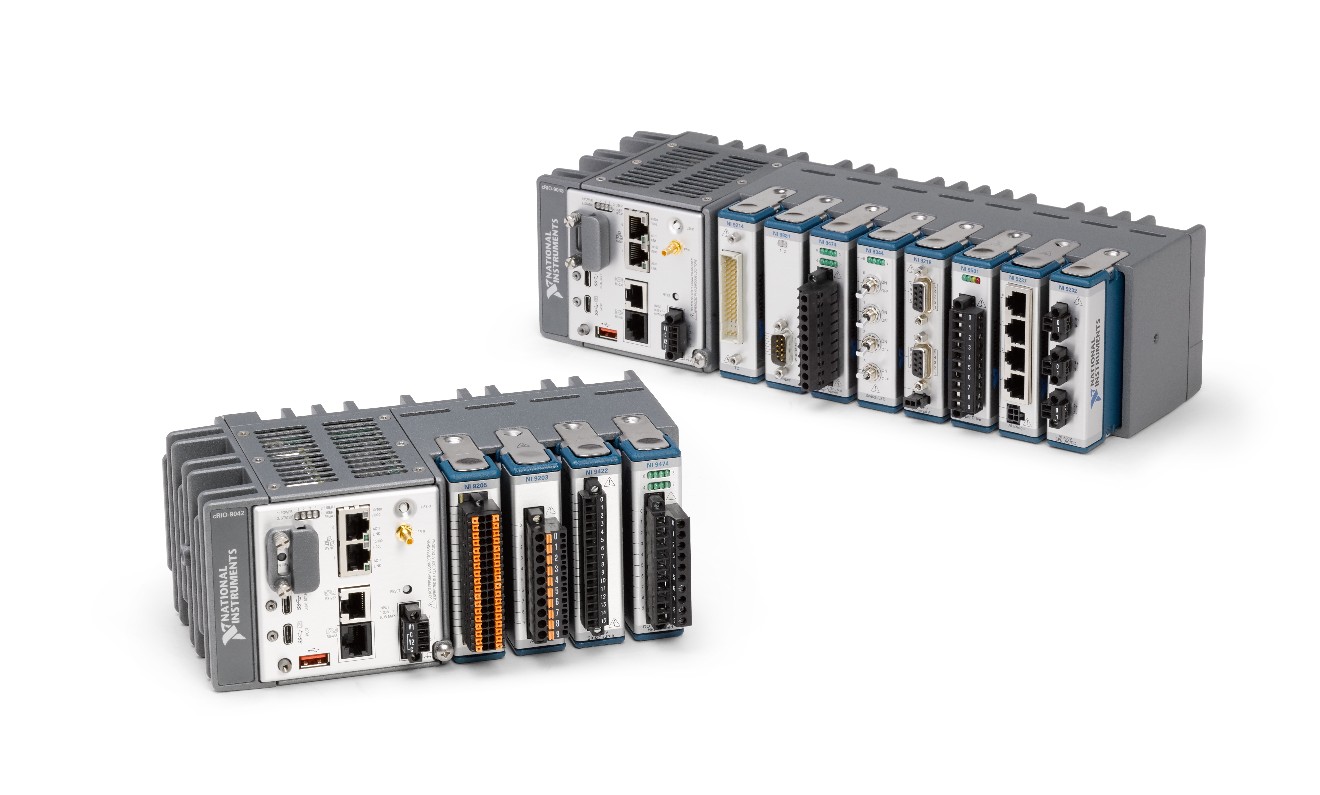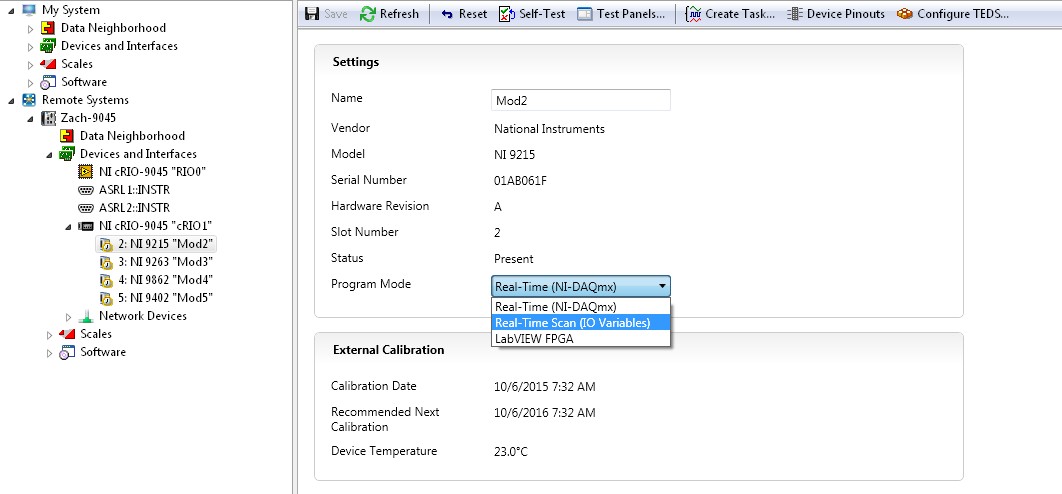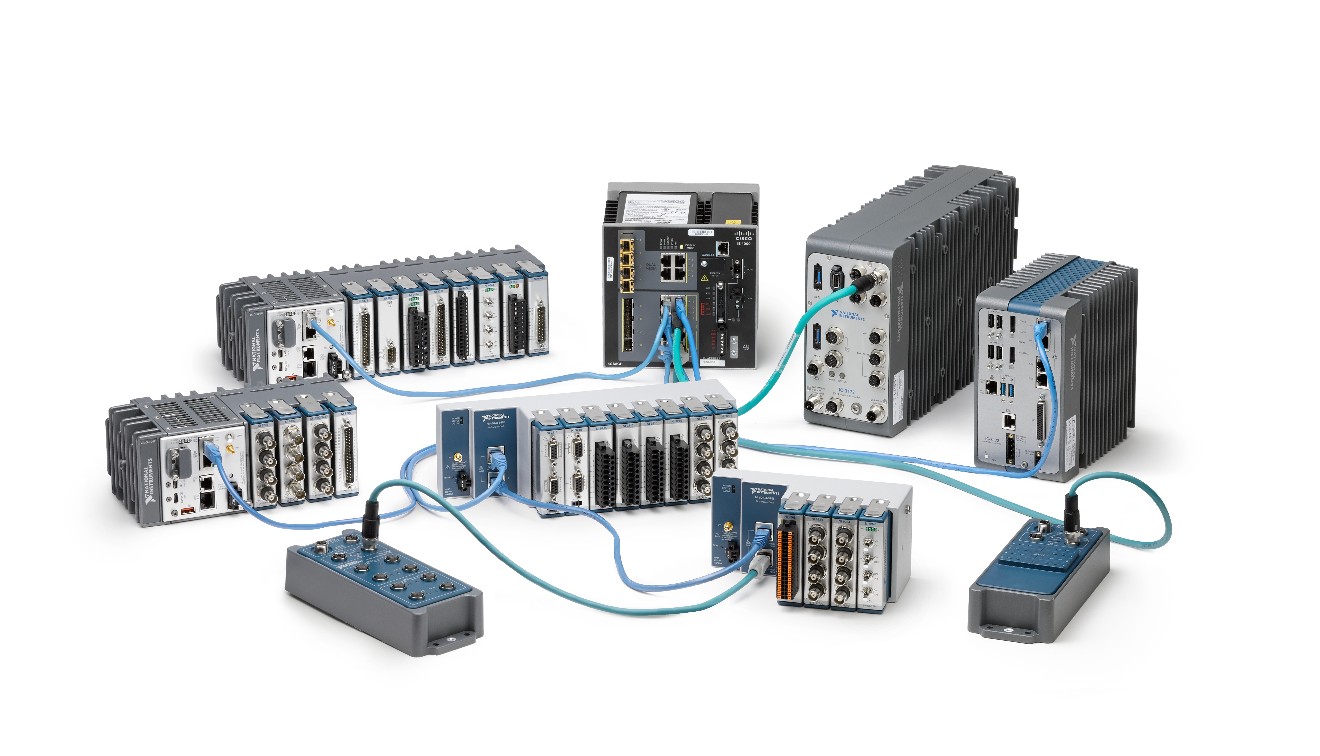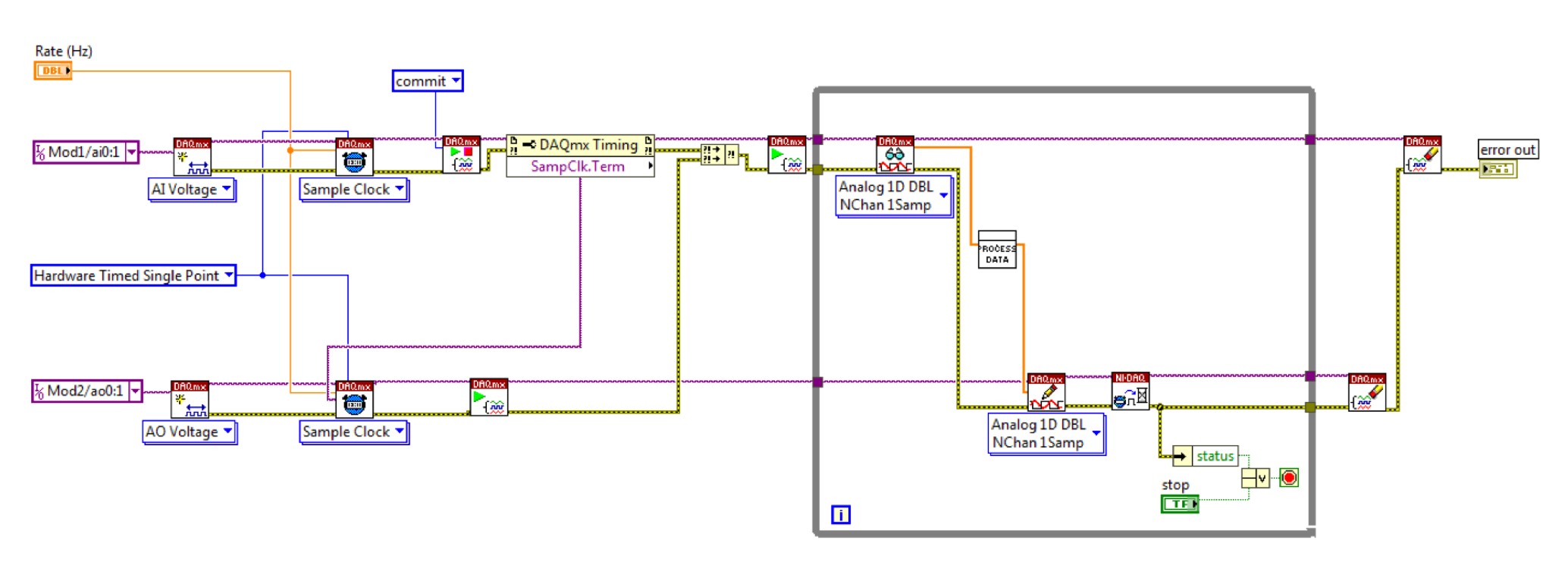What is CompactRIO with NI-DAQmx?
Overview
CompactRIO with NI-DAQmx is the latest addition to the CompactRIO controller family. It brings two software experiences into one by combining the ease of use of NI-DAQmx and the low-level functionality of LabVIEW FPGA. CompactRIO with NI-DAQmx also uses the latest in synchronization technology, Time Sensitive Networking (TSN), to simplify system architectures. Leverage over 100 C Series Modules to connect to any sensor on any bus: each module features built-in signal conditioning and high accuracy A/D converters.
The cRIO-904x and cRIO-905x controllers are the first to support NI-DAQmx.
Contents
- Use the Right Tool (Programming Mode) for the Right Task
- Simplify Distributed Measurement and Control with Time Sensitive Networking (TSN)
- Additional Features
- Learn More
Use the Right Tool (Programming Mode) for the Right Task
CompactRIO with NI-DAQmx features a heterogeneous computing architecture, consisting of a real-time (deterministic) processor and FPGA. It is ideal for measurement and control applications and supports multiple APIs to help accomplish each of these tasks quickly. Specifically, the controllers support three user-selectable modes for each slot:
- Real-Time (NI-DAQmx) – Intuitive API for quick and accurate measurements as well as the ability to perform deterministic control up to 5 kHz that executes on the real-time processor.
- Real-Time Scan (IO Variable) – Single-point data accessible from LabVIEW Real-Time for control up to 1 kHz. This mode is primarily for migrating existing applications. It is recommended to use NI-DAQmx instead for new applications.
- LabVIEW FPGA – Single-point data accessible in the FPGA for high speed control up to 10s of MHz, custom protocols, and co-processing.
By default, all modules start in Real-Time (NI-DAQmx) mode to accelerate the setup process. When beginning to program the controller, NI-DAQmx allows for a faster time to capturing measurements and performing deterministic control on the processor up to 5 kHz (904x) and 2.5 kHz (905x). LabVIEW FPGA mode will support loop rates of up to 10s of MHz and achieve hardware levels of determinism and reliability.
Figure 1. Three User-Selectable Programming Modes in NI MAX
Simplify Distributed Measurement and Control with Time Sensitive Networking (TSN)
All CompactRIO with NI-DAQmx controllers support TSN, which is an update to standard Ethernet that adds network-based time synchronization and deterministic communication. Distribute measurements around a system using multiple CompactRIO controllers connected with a 3rd party TSN-enabled switch or by daisy-chaining TSN-enabled CompactDAQ chassis or FieldDAQ devices (no longer sold) directly to the controller. TSN support also means it can be part of a larger distributed network of TSN-enabled devices which have a synchronized time source and can send both control data and best effort data along the same standard Ethernet cable. All Ethernet ports support TSN, allowing for a variety of architecture options around TSN.
Figure 2. TSN-enabled family includes CompactRIO, CompactDAQ chassis, FieldDAQ (no longer sold), and Industrial Controllers.
Additional Features
In addition to dual port TSN support and multiple programming modes optimized for different tasks, CompactRIO with NI-DAQmx offers several other features.
Analyze More Data and Perform More Control with the Latest Intel Atom Processor
The CompactRIO with NI-DAQmx controllers use the Intel Atom E3900 series Apollo Lake processors to achieve the highest performance ever in a CompactRIO controller. USB3 and Ultra High Speed (UHS) SD removable storage address the demands of high performance data logging with double the memory density and increased performance to allow for more analysis and control. Display is provided via ruggedized USB Type-C connectors to integrate a human machine interface (HMI) into your data logging, control, or monitoring application. These performance improvements are achieved while maintaining the same physical dimensions and environmental specifications as its predecessors. The Intel processor runs NI Linux Real-Time, a real-time OS based on a standard kernel and designed specifically for reliable and deterministic operation in long-term deployments.
Powerful Co-processing with a User-Programmable FPGA
The user programmable FPGA allows you to offload time-critical processes for advanced control, signal-processing, filtering, advanced timing, and other logic. Beyond direct access to I/O for high speed control, the FPGA can help process and analyze data to accelerate time to insight and decision making. NI uses the latest FPGA technology from Xilinx, with chips that contain up to 236,080 logic cells, and 840 DSP slices. Rather than traditional HDL tools, the FPGA is programmed using LabVIEW FPGA for a more intuitive experience to programming the hardware.
Accomplish More with NI-DAQmx on CompactRIO
Beyond supporting NI-DAQmx on CompactRIO, the driver has also improved to allow for more customization and control. The new controllers provide a hardware timing engine per slot to allow for better customization with multi-rate applications. They also support deterministic control up to 5 kHz (904x) and 2.5 kHz (905x) with the addition of support for Hardware-Timed Single Point.
Using hardware-timed single-point, samples are acquired or generated continuously using hardware timing and no buffer. Use hardware-timed single-point sample mode if you need to know if a loop executes in a given amount of time, such as in a control application. Because there is no buffer if you use hardware-timed single-point sample mode, ensure that reads or writes execute fast enough to keep up with hardware timing. If a read or write executes late, it returns a warning or error.
Figure 3. Example of Hardware-Timed Single-Point Using NI-DAQmx
Survive the Industrial Environments with Rugged Packaging
The CompactRIO Controller delivers unrivaled control and acquisition capabilities in a compact, rugged package and features an operating temperature range of up to -40 °C to 70 °C (-40 °F to 158 °F); 50 g shock and 5 g vibration ratings; redundant power supply inputs; and a variety of international safety, Hazloc, and environmental certifications and ratings for operation in harsh industrial environments.
Leverage a Vast Ecosystem and Improve Security with NI Linux Real-Time
Harness the openness of NI Linux Real-Time through thousands of open-source applications, IP, and examples, while collaborating with an active community of users and developers. National Instruments developed the Linux-based real-time OS (RTOS) through years of R&D development and collaboration with the Real-Time Linux project. Use OPKG package manager to install, manage, and make use of the ecosystem online.
Boost security and reliability with native support for Security-Enhanced Linux. Security-Enhanced Linux (SELinux) is a mandatory access control (MAC) based system that uses a security policy to explicitly specify the actions that each component of the system is allowed to perform.
Connect to the Outside World
Eliminate the need for separate subsystems by connecting components directly to your CompactRIO Controller with built-in processor I/O such as Gigabit Ethernet, serial, USB ports, and over 100 I/O modules with measurement-specific signal conditioning.
Signal Type Analog Input1 | Channels | Measurement Types | Max Rate | Special Features |
Voltage | 2, 4, 8, 16, 32 | ±200mV, ±500mV, ±1V, ±5V, ±10V, ±60V, 3Vrms,300Vrms, 400Vrms, 800Vrms | 1 MS/s/ch | Ch-ch insolation, high-voltage bank isolation, anti-aliasing filters |
Current | 4, 8, 16 | +/-20mA, 5Arms, 20Arms, 50Arms | 200 kS/s | Anti-aliasing filter, ch-ch insolation, built-in shunt resistors |
Universal | 2, 4 | V, mA, TC, RTD, strain, Ω, IEPE | 51.2 kS/s/ch | Excitation, bride completion, anti-aliasing filters, ch-ch isolation, built-in shunt resistors, amplification |
Thermocouple | 4, 8, 16 | J, K, T, E, N, B, R, and S types | 75 S/s/ch | CJC, bank insulation, amplification, filtering, ch-ch insolation |
RTD | 4, 8 | 100 Ω, 1000 Ω | 400 S/s | 50/60 Hz filtering |
Strain/Bridge Based | 4, 8 | ¼, ½, full bridge (120 or 350 Ω) | 50 kS/s/ch | Excitation, bridge completion, anti-aliasing filters |
Acceleration and Sound | 3, 4 | ±5V, ±30V | 102.4 kS/s/ch | IEPE, anit-aliasing filters |
1Up to 24bit resolution
Signal Type Analog Output1 | Channels | Measurement Types | Max Rate | Special Features |
Voltage | 2, 4, 16 | ±10V, 3Vrms | 100 kS/s/ch | Ch-ch insolation, bank isolation |
Current | 4 | 0mA -20mA | 100 kS/s/ch | Open-loop detection |
1Up to 24bit resolution
Signal Type Digital I/O | Channels | Measurement Types | Max Rate | Special Features |
Input | 4, 8, 16, 32 | LVTTL, 5VTTL, 12V, 24V, 30V, 250 VDC/VAC | 55ns | Ch-ch insolation,bank isolation, sinking and sourcing |
Output | 4, 8, 16, 32 | LVTTL, 5VTTL, 12V, 24V, 60V, 0V-50V programmable | 55ns | Ch-ch insolation,bank isolation, sinking and sourcing |
| Input/Output | 4, 8, 16, 32 | LVTTL, 5VTTL, 12V, 24V | 55ns | Ch-ch insolation,bank isolation |
| Relays | 4, 8 | 30VDC, 60VDC,250VAC, SPST and SS | 1op/sec | Ch-ch insolation,bank isolation |
Special Signal Type | Channels | Measurement Types | Max Rate | Special Features |
Motion | 1, 4 | Step/dir. CW/CCW,analog PWM | N/A | Stepper and servo drive signals, incremental encoder feedback |
Synchronization | 1, 3 | Cabled, GPS | N/A | Pulse per second accuracy of ±100ns for multichassis synchronization |
Connect directly to industrial cameras and motors to create custom image processing and motion control algorithms. You can also take advantage of an extensive 3rd party library of modules built by companies like SEA and Kistler. Use your CompactRIO Controller as an industrial gateway and connect to a variety of devices and infrastructures with native support for industrial protocols like PROFINET, OPC UA, and EtherCAT. Design interactive, feature-rich GUIs and connect to local, remote, or mobile HMIs for data visualization and operator interfaces.
Additional Programming Modes
There are two other programming modes for C Series modules using NI-SERIAL and NI-XNET:
- Real-Time (NI-XNET) – This mode will be seen in NI MAX and LabVIEW for all XNET C Series modules.
- Real-Time (NI-SERIAL) – This mode will be seen in NI MAX and LabVIEW for all Serial C Series modules.



